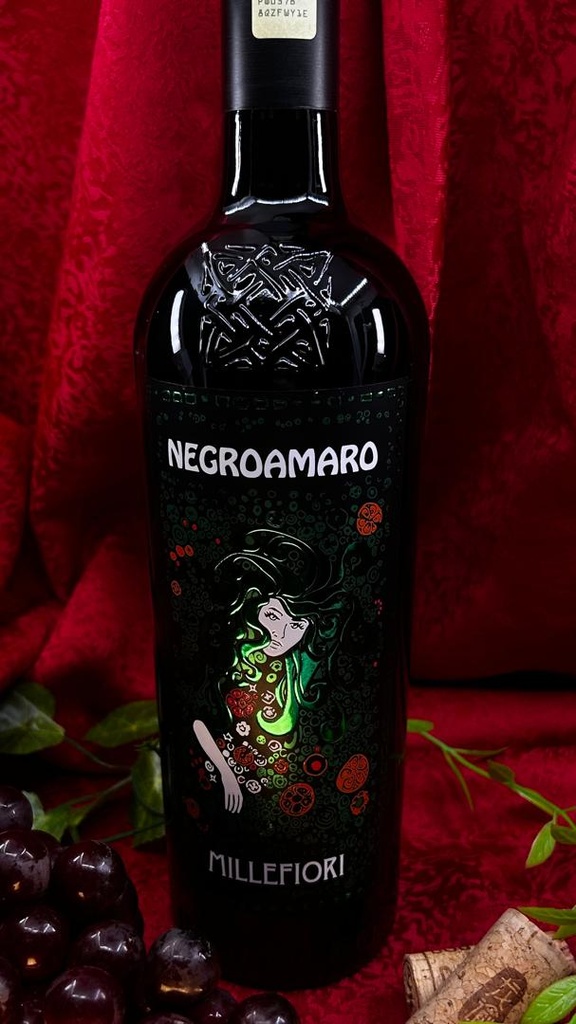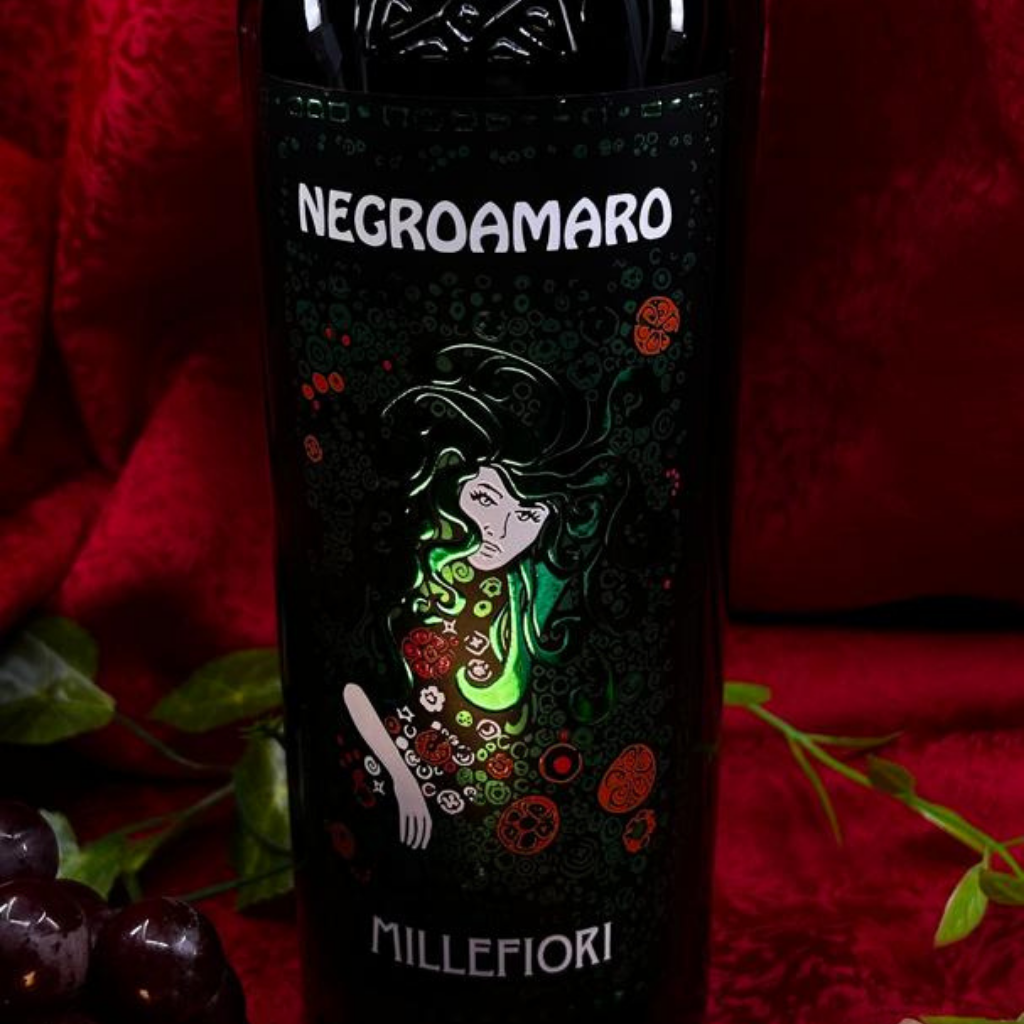2000 Millefiori Negroamaro
2000 年 Millefiori Negroamaro 是一款产自普利亚的中度至浓郁酒体葡萄酒,以深色水果、草本和辛辣味而闻名。它具有结构化的单宁和
持久的余味,非常适合搭配烤肉、
烤蔬菜和陈年奶酪。
| Wine Style: Red |
| County: Italy |
| Grapes Variety: Negroamaro |
| Tasting: Full-Bodied |
The 2000 Millefiori Negroamaro is a red wine crafted from the Negroamaro grape variety, which is primarily grown in the southern regions of Italy, particularly in Puglia (the "heel" of the Italian Peninsula). Negroamaro is known for its deep, rich colors, full-bodied profile, and dark fruit flavors. The 2000 vintage of Millefiori is a specific bottling from this grape, and here's a detailed breakdown of its ingredients and information:
Ingredients:
- Negroamaro: The key grape variety used in the 2000 Millefiori Negroamaro. This grape is native to the Puglia region in southern Italy and produces wines that are dark, bold, and often earthy with deep fruit flavors. Negroamaro wines typically feature aromas and flavors of ripe blackberries, plums, cherries, and earthy notes, often complemented by spices such as black pepper and herbs.
- Aroma Profile: Earthy, dark fruits (blackberry, plum, cherry), herbs (rosemary, thyme), and spices (black pepper, clove).
- Taste Profile: Full-bodied, with rich dark fruit flavors, balanced acidity, and moderate to high tannins. The wine may have a slightly rustic quality with an intense finish.
Tasting Notes for the 2000 Vintage:
- Appearance: Deep ruby red, possibly showing some garnet hues as it ages.
- Aromas: Dark berry fruits (blackberry, black cherry), herbal notes (rosemary, oregano), and some earthy, rustic qualities. With age, you might also find hints of leather, tobacco, and dried fruit.
- Palate: Full-bodied, with a rich concentration of fruit flavors balanced by smooth tannins. The wine is likely to show signs of aging, with softened tannins and a more complex bouquet. Flavors of dark fruit, herbs, and a touch of spice are balanced by a hint of earthy undertones.
- Sweetness: Dry
- Acidity: Moderate
- Tannins: Medium to high, providing structure and aging potential.
Alcohol Content:
- 13.5% to 14% ABV (this may vary slightly depending on the specific winemaking practices for the 2000 vintage).
Winemaking Process:
The Millefiori Negroamaro 2000 would have been made using traditional winemaking methods, likely with fermentation in stainless steel or concrete vats to preserve the natural fruit character of the Negroamaro grape. The wine would have been aged in oak barrels (likely French or American oak) to impart subtle flavors of vanilla, spice, and structure. The 2000 vintage is now well into its aging process, which has allowed the wine to develop complexity and a smooth, mature profile.
Region:
- Puglia: The Negroamaro grape is primarily grown in the Puglia region, particularly in the Salento Peninsula. This area is known for its hot, dry climate, which is ideal for ripening full-bodied red wines. Puglia is home to some of Italy's most iconic native grape varieties, with Negroamaro being one of the most prominent. The warmth of the region helps the grapes to ripen fully, producing wines that are rich and powerful.
Food Pairing:
The Millefiori Negroamaro 2000 pairs well with a variety of hearty dishes, including:
- Grilled meats (steak, lamb, sausages)
- Roast meats (beef, pork)
- Pasta dishes with rich, meaty sauces (e.g., Bolognese or ragu)
- Aged cheeses (Parmigiano-Reggiano, Pecorino, Manchego)
- Mushroom-based dishes or truffle-based recipes
Aging Potential:
- As a wine from the 2000 vintage, this bottle has had ample time to age and develop its complexity. Negroamaro wines are known for their aging potential, and with nearly two decades of aging, the Millefiori Negroamaro 2000 should be at or near its peak, displaying softer tannins and a more developed, nuanced flavor profile. However, if stored properly, it could continue to age for a few more years, developing additional tertiary flavors like leather, tobacco, and dried fruit.
Serving Recommendations:
- Ideal Serving Temperature: The 2000 Millefiori Negroamaro should be served at a slightly cooler than room temperature, ideally between 16°C to 18°C (60°F to 65°F). This temperature range allows the wine to open up fully while maintaining its structure and complexity.
- Glassware: Use a large, tulip-shaped red wine glass. This will allow the wine to breathe and concentrate its aromas. A larger glass helps bring out the rich fruit and earthy aromas typical of Negroamaro while also enhancing the wine’s smooth texture on the palate.
Decanting Recommendations:
- Decanting Time: As the 2000 Millefiori Negroamaro is an aged wine, decanting is recommended to allow it to aerate and release its complex aromas. Decant the wine for 30 minutes to 1 hour before serving. This will help soften the tannins and allow the wine to evolve in the glass, showcasing more nuanced flavors, especially after its long aging process.
- Why Decanting is Important: Decanting an aged wine like the 2000 Millefiori Negroamaro is important for two reasons:
- Aeration: It allows the wine to interact with oxygen, helping to open up and soften any remaining tannins while releasing secondary and tertiary aromas that have developed during aging.
- Sediment Removal: Aged wines like this one may have developed sediment during the aging process. Decanting helps separate the wine from any sediment, ensuring a smoother, cleaner pour.
- How to Decant: To decant, gently pour the wine into a decanter, keeping the bottle upright to minimize disturbing any sediment at the bottom. You should see the sediment collect at the bottom of the bottle, and once you notice the sediment nearing the neck, stop pouring.
Tasting Experience:
Once decanted, the wine will reveal its deep, dark fruit flavors (blackberry, plum) alongside earthy and herbal notes, with subtle hints of leather and tobacco. Over time, as the wine continues to aerate, the wine’s tannins should soften, allowing the more nuanced and aged characteristics to emerge.



